Calendula flower may be the brightest little flowering herb we grow. Don’t let its size fool you, however! The many calendula flower uses in both the garden & our recipes far outweigh its size.
This post may contain affiliate links at no additional cost to you. By making your purchases through the links on this website, IMSL may make a small percentage at no direct cost to you. IMSL only promotes products we use & truly believe in. Please refer to my Privacy & Disclosures for further information. IMSL thanks you for your support!
OUR ETSY SHOP IS NOW OPEN!
If you’ve read a bit here at IMSL, you know that the calendula flower is one that we grow & use often here on the hill. Calendula flowers uses are plenty. Both in the garden and in our kitchen witchery. Not only is it a joy to view growing in the garden, its functions as a companion plant amongst our veggies is par-none.
And did we mention it’s most likely the easiest to grow year-to-year in our gardening beds? For us in gardening zone 5b, planted once & done. This plant readily self sows year to year but remains non-invasive. Our kind of plant!
Calendula, aka “Calendula officinalis” or pot marigold, has been used throughout the centuries for many uses. Culinary, medicinal, & cosmetic applications utilize this sunny tiny flower to its fullest potential.
DRYING CALENDULA
A few of calendula uses that are listed below require dried calendula flowers. This is a simple process when harvesting fresh calendula flowers. View our short video below for simple harvesting & drying suggestions.
Harvesting fresh calendula should be done on a bright sunny day, after the flowers have dried completely from the nights dew. Grab the flowerhead and snap at the base of the flower.
To dry the flowers, place them in an area with good airflow (we use an antique sifter for this purpose but a cooling rack or screen would work as well) until completely dry. Depending on your area & humidity levels, this could take just a few days to 14 days. For those in high humidity areas, using a dehydrator is always an option. You know when they are completely dry when you squeeze the base of the flowerhead (where it attaches to the stem) and it feels dry & brittle.
If you don’t have access to fresh calendula flowers, you can purchase dried organic flowers online.
CAN YOU EAT CALENDULA FLOWERS
In a nutshell, yes. Ok, maybe you would enjoy the fresh petals of these sunny flowers in calendula recipes such as salads, or used in dishes & condiments (herbal butters or cheese spread anyone?), the same as you would saffron instead of a nutshell 🙂 The leaves are also edible albeit a bit bitter for our liking.
Not only are the fresh petals edible, they are also nutritious. The petals are considered an antioxidant, mostly from the flavonoids & carotenoids contained within. Flavonoids help your body function at its optimal best while protecting it from daily toxins & stress. Carotenoids, are part of the bodies antioxidant defense system. Both are important in maintaining healthy functioning systems.
Calendula also boasts the ability to create Vitamin A in the body due to the lutein & beta-carotene, both antioxidants & found within the leaves, which aid in maintaining healthy vision & skin.
Additionally, calendula’s edible nutritional benefits extend to include fatty acids (the two main being calendic & linoleic acids) as well as being rich in oxygenated oils (monoterpenes & sesquiterpenes).
Back to that nutshell? Yes, you can eat the flowers, petals, and leaves of the calendula plant. Give it a taste next time you see some growing in a garden near you 🙂
An enjoyable way to use the brightly colored fresh petals when available is making compound butter. A beautiful addition to any meal, holiday celebrations anyone?
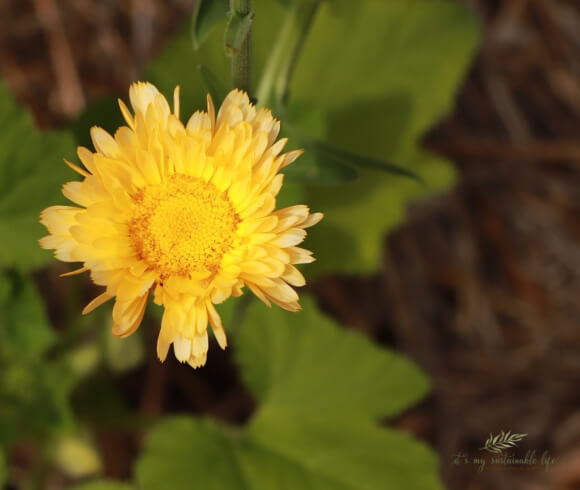
CALENDULA BLOSSOM COMPOUND BUTTER RECIPE
Compound butter is a wonderful addition to any table when fresh herbs are used. A compound butter is simply butter that has been “infused” with herbs.
To make calendula blossom compound butter simply remove the petals from the flowerhead(s). Enough to fill 1/2 cup to 3/4 cup, from fresh, organically sourced flowers. Take 2 sticks of organic butter, or 1 cup, (room temperature) & place into bowl. Using beaters, whip the butter until smooth & fluffy. Using a wooden spoon, carefully incorporate the petals into the butter, distributing evenly.
Form the butter to your liking. Make it pretty if you like by utilizing molds, butter presses, into a log & slice (a sushi mat works great for this), or even rolling out slightly chilled butter and cutting out forms with cookie cutters.
PRO TIP: Make your compound butter during the height of the growing season, seal, and freeze for all your upcoming gatherings!
CALENDULA FOR CHICKENS
Not only is calendula edible for humans, but chickens love it & can benefit from it as well! Thank you Lisa from Fresh Eggs Daily for the pointers on using calendula & marigold with chickens!
Serving up calendula petals in with their food is not only a tasty treat for your beloved birds, but can help with inflammation of the mouth, thrush, & yeast issues as well. And did we mention the deep colors of the petals help to naturally deepen the yolks of their eggs!
CALENDULA & LIVESTOCK
Calendula tea (recipe below) in a spray bottle (kept in the refrigerator) is a wonderful tool for use with livestock. NOTE: utilize the same caution list below when using with animals, thus, not recommended for use on any pregnant animal.
Use this tea spray for cases of skin irritations. As an alternative, make the calendula salve and rub on affected spots.
CALENDULA CAUTIONS & SIDE EFFECTS
Most often the use of calendula both internally as well as externally is safe. However, as with any herb there are a few precautions to be aware of.
Pregnant women & women breastfeeding should not utilize calendula products due to its highly potent pro-menstruation effects. According to Penn State, calendula could possibly interfere with conception as well.
Calendula may cause allergic reactions, especially to those sensitive to ragweed, marigolds, daisies, echinacea, chamomile, or any plant in the Asteraceae/Compositae family. Those with food plant-based allergies should consult with their primary care physician prior to taking calendula.
Calendula products may cause excessive sleepiness, especially if taken with sleep aids such as clonazepam, Ambien, and lorazepam.
Calendula may adversely interact with blood pressure medications as well as those with diabetes.
CALENDULA OIL
Making your own calendula oil from flowers you’ve harvested yourself, or purchased dried, is easy, versatile, and amazingly beneficial. For complete, in-depth instructions on how you can make your own, visit “How To Make & Use Calendula Oil”.
This luxuriant oil can be used directly to the skin or when making your own homemade personal care products.
“Infused into an oil it can be used for skin issues ranging from diaper rash, eczema/psoriasis, acne, and dry/chapping skin.”
IMSL
Calendula oil is the star ingredient of many homemade recipes and is something we make in abundance every growing season.
CALENDULA TEA – IS IT SAFE TO DRINK
Yup! And more than just safe to drink for most (certain cautions are listed above). Calendula tea has many applications…19 applications that we can think of. Everything from an eyewash to treat pink eye and dry itchy eyes from pool or chlorinated water, eye strain, & allergies to assisting in internal relief from…
“bladder infections, upset stomach, cleanses the digestive tract, & relieves digestive disorders”
IMSL
There are several ways to make calendula tea. Either a simple quick tea or an infusion. What is the difference between tea and infusions?
“Although both are considered infusions, there are differences. As stated, an infusion utilizes large amounts of herb and steeped a long period of time. Tea, however, typically using just the leaves of the plant, utilizes smaller amounts of the herb and are steeped for a much shorter time period.”
IMSL
CALENDULA TEA RECIPE
To make a simple calendula tea, use 1 Tbl to 2 Tbl fresh petals (2 Tbl dried) to approximately 2 cups boiling water. Experiment with the amount to find your perfect cup. Cover and allow to steep for 8-10 minutes.
Alternatively, place the above listed ingredients into a saucepan, bring to a boil and simmer for 8-10 minutes. Serve & consume immediately.
CALENDULA INFUSION
As stated, an infusion utilizes larger amount of herb and is steeped over a longer period of time. To make a calendula infusion, fill a mason jar (size of your choice) 1/2 to 3/4 way full of calendula petals. Cover with boiling water, cover the jar and let sit for 8-10 hours or overnight.
We love to make “long” infusions, however they can be intense for some.
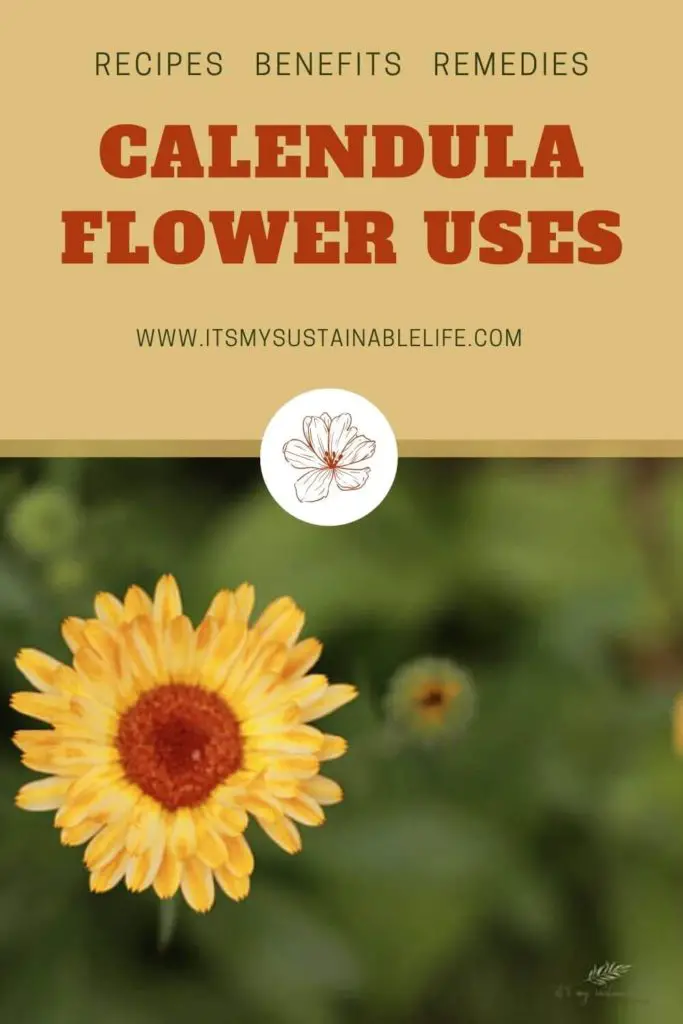
CALENDULA TINCTURE
Anyone who knows IMSL know we love our tinctures. And why not? They are easy to make, efficacious, and have a long shelf life. WIN, WIN!
Tincturing here on the hill during the height of the growing season is a common event. When we need a higher concentration of the herbs active substance, we tincture. Everything from creating our own Elderberry Tincture to using our Yarrow Tincture in our homemade hand sanitizer (recipe coming soon), tinctures are one of our must haves in our home apothocary.
To create calendula tincture you need just two ingredients.
- ALCOHOL OR ALCOHOL SUBSTITUTE – (80 to 100 proof), we like to use vodka in our tincturing process as there is little to no flavor, or you can substitue brandy, or rum. Those with young children or alcohol sensitivites can also look to using glyceryn
- ORGANIC CALENDULA FLOWERS – The proper ratio of flower to liquid is typically 1:5 dry herb and 1:2 fresh. We normally use fresh as we make it during the growing season and don’t want to wait for it to dry 🙂
To prepare the tincture fill your jar with fresh or dried flowers (preferably bruised, ground, or torn to maximize the infusion process) and cover with the “alcohol” of your choice. Seal and place in a dark cupboard for steeping a minumum of 6-8 weeks, making sure you give it a good shake every couple days. When complete, strain & compost the flowers, seal, label, and your tincture is ready to use.
Calendula tincture is used for those needing aid when dealing with menstruation cramps, stomach issues, ulcers, and chronic infections.
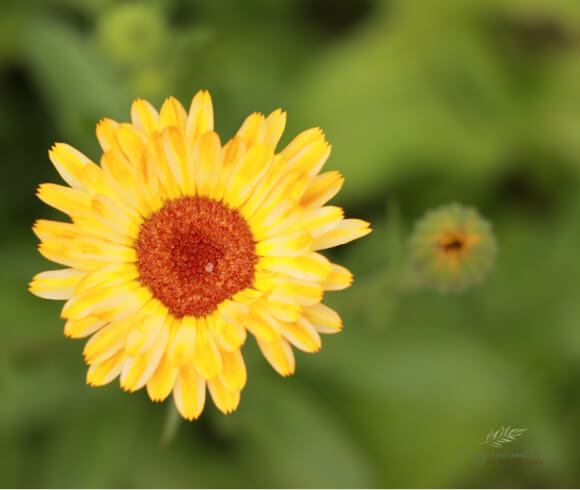
Don’t want to make your own? We offer a variety of products here on the hill. Click the Etsy Shop button below for a full listing.
CALENDULA SALVE – THE BEST FOR ITCHY SKIN
If you’ve never made a salve, balm, or lotion, why not? If you are unsure on what the differences are, “Balms, Salves, & Butters” can help. Salves are quick, inexpensive to make, and so worth the little time it takes to create.
To make calendula salve, which is wonderful addition to any home apothocary or first aid kit, follow our detailed instructions found at “Dandelion Salve & Its Many Uses”. Simply substitute the calendula oil (instructions for making the oil can be found above) for the dandelion oil.
Calendula salve is great to have on hand to soothe skin irritations, dry itchy areas of the skin, diaper rash, insect bites & so much more! Don’t forget your farm animals & pets as well!
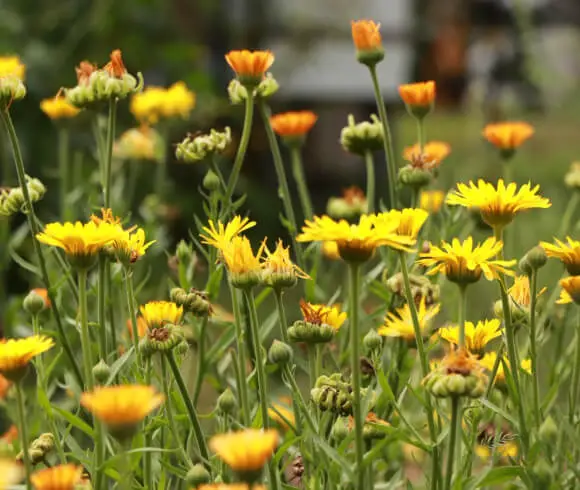
CALENDULA HYDROSOL
Sounds difficult to make & a bit “sciencey” doesn’t it? Hydrosols are easy & quick to make and is a wonderful way to have on hand a refreshing spritz that’s so beneficial to use!
Stephanie over at Hello Glow has a great tutorial on how easy it is to make your own hydrosol. Her easy to follow instructions will have you using your own calendula hydrosol as an ingredient in lotions, creams, after sun spray & as a facial toners in no time at all.
CALENDULA AFTER SUN SPRAY
Nothing soothes sun kissed skin like an after sun spray & making your own using .5 oz of calendula hydrosol and .5 oz aloe vera juice is quick & easy. Pour the two ingredients in a spritz bottle & spray away as needed. This product should be kept refrigerated and will last only a few days.
CALENDULA & ELDERBERRY ELIXIR
Here on the hill we love our elderberry products, especially our elderberry syrup & elderberry tincture. Inspired by The Herbal Academy, this is one elixir we will be putting in our healing cabinet.
Using fresh calendula flowers organically sourced along with other beneficial, immune boosting ingredients, this exlixir sounds like just the ticket for cold & flu season.
To make take the following ingredients and add to a quart size mason jar….
- 1 C fresh calendula flowers (2/3 c dried)
- 2/3 C dried elderberries (1 1/3 C fresh/frozen, we’ve taken this from our elderberry syrup recipe conversion)
- 1/2 C fresh elderflower (1/3 C dried)
- 1/2 C fresh rose hips (1/3 C dried)
- 2 Tbl fresh orange peel (1 Tbl dried)
- 1 Tbl fresh ginger (1 tsp dried)
- Brandy
- Honey
The following directions are courtesy of The Herbal Academy, to whom I greatly thank for this recipe!
- Fill a clean, sterilized quart jar (4 cup capacity) with herbs.
- Add brandy, pouring until herbs covered by 1-2 inches of brandy and jar is approximately 3/4 full.
- Add honey, leaving 1 inch of space at the top of the jar.
- Poke chopstick into jar to release any trapped air bubbles and ensure brandy and honey are coating herbs.
- Put cap on and label jar with ingredients and date.
- Let steep for 4-6 weeks in a cool, dark place, shaking daily.
- Filter elixir by pouring through a fine mesh filter or several layers of cheesecloth over a bowl or wide-mouth jar. Press the marc (plant material) to squeeze out every last drop of elixir.
- Compost the marc and cap and label the elixir.
As with any home remedy, play with the amounts used & needed to find your sweet spot of perfection 🙂
CALENDULA LOTIONS
Making homemade moisturizing lotions is one of our most favorite personal care products here on the hill. Our base recipe can be found at HERE and is one we use all year long.
Why take the time to make your own? We said it best if we can tout our own horn a bit 🙂
“Our skin is the largest organ in our body. It’s alive, breaths and absorbs all it comes into contact with. It protects us. It’s an organ worth noting and taking the best care of possible. Keeping your skin healthy and supple, with as limited additional chemical exposure as possible, is the least we can do for our hardworking epidermis!”
IMSL
To make a skin nourishing calendula moisturizing lotion, using the above calendula oil recipe, follow the directions listed at “How To Make The Best Homemade Moisturizer For Dry Winter Skin” to make your lotion. And it is the best. Just sayin’ 🙂
CALENDULA LOTION BARS
To make a healing calendula lotion bar simply add 1/4 Cup each of calendula oil, beeswax (shaved), & the butter of your choice. Shea, mango, or cocoa butters are all great options. To make a vegan version of this lotion bar substitute about half as much candelilla wax in lieu of the beeswax.
Place all the listed ingredients in a double boiler & melt slowly over medium to low heat. Once all has melted, pour into silicone molds to cool & harden.
Lotion bars are exceptional to rub directly on extremely dry cracked skin like hands, elbows, & feet. Storing these lotion bars away from heat (we like to refrigerate ours) will extend the shelf life greatly. Typically in a cool, dark area they will last around 9 months or more.
SIMPLE CALENDULA FLOWER USES
In addition to the above recipes, there are a few simple calendula applications that are a bit more easy to make.
- SUGAR SCRUB – Add fresh or dried calendula petals, to equal parts brown sugar. Add enough water to make a paste. Spread over area you are wanting to exfoliate. Leaves the skin soft & supple.
- WATER INFUSION – Make a simple calendula water through the infusion methods we spoke about above. Use this water in any lotion recipe in lieu of whatever water is called for in the recipe
- CALENDULA SOAK – Take 1/4 to 1/2 C of dried oats, 4 Tbl fresh calendula flowers & grind to a fine powder. Add to 1/2 C epsom salt and mix together. Add essential oils of your choosing…lavender is our favorite. Seal and store until needed. Add 1/2 C to 2/3 C of this mixture to your bath to relieve itchy skin issues. Optional is to add this mixture to a muslin bag and then add to the tub.
- HERBAL SINUS INFUSION – During cold & flu season, we utilize the Neti Pot to clean our sinuses. This herbal infusion recipe offered by Fresh Egg Daily, using fresh calendula flower, thyme, & sage is one we will be making and having on hand.
There are no limits as to the uses of calendula. It’s healing benefits, both internally as well as externally make this herb an absolute must for any kitchen witchery & home healing cabinets.
Do you have other uses that we’ve not mentioned? Love for you to share them below in the comments! Until next time, be sure to follow IMSL on all social media channels found below.
Love, Light, & Laughter ~


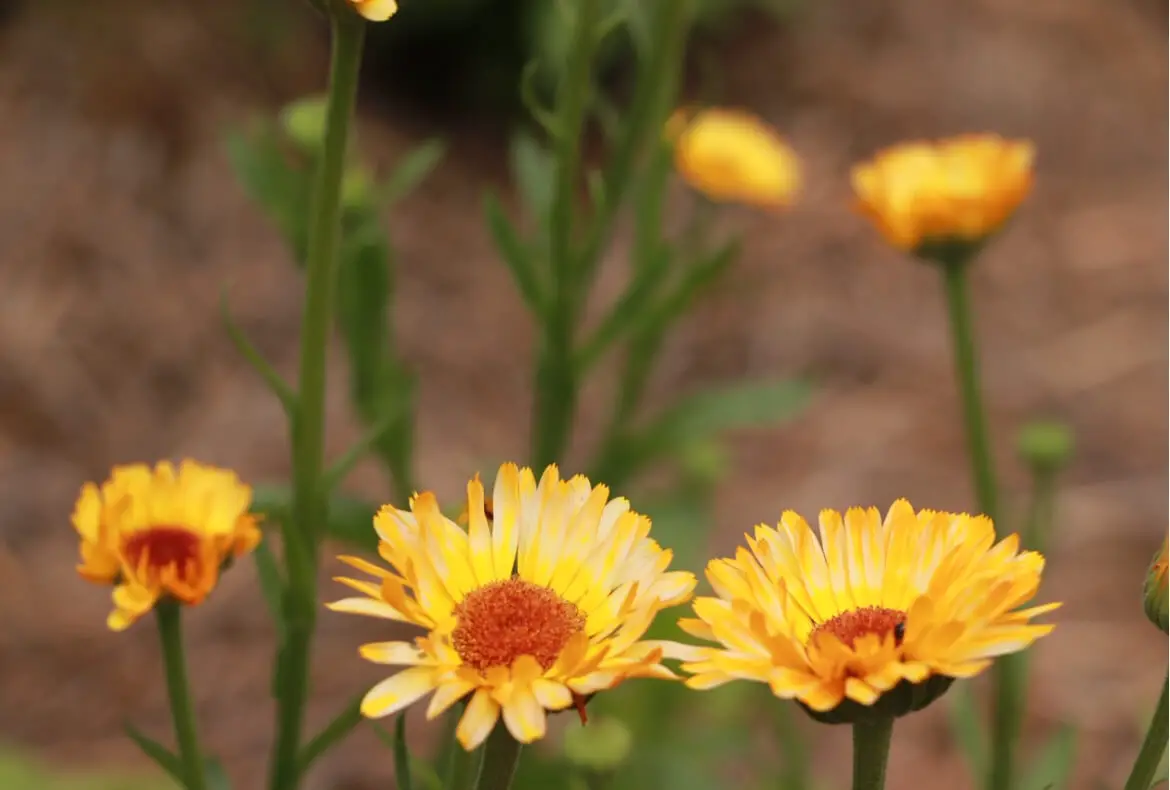
44 comments
My husband just picked me a calendula yesterday on New Year’s Day! A sweet blessing!
Thanks for sharing all the wonderful uses!
Laurie
Ridge Haven Homestead
Great post! There is a YouTuber I watch who always makes tintuctures out of calendula, so this post helped me put some of the pieces together in terms of the flower. Thanks for sharing!
Jenna ♥
Thank you so much for this wonderful information on calendula! I am glad to have learned a little bit more about natural stuff.
Amazing info! I had no idea!
That is a beautiful flower with a surprising number of uses. You are a wealth of knowledge.
I love this flowering herb! I use it in skin serums. And it is so easy to grow.
It has so many wonderful uses we love it as well. Thanks for stopping by, Cindy!
Very cool. I knew you could used calendula oil for skin care but had no idea you could eat it as well. It’s such a pretty flower too!
Wow that is an amazing plant!
Wow! A lot of information and had no idea of all of these possibilities. Thank you for sharing.
Woah! I knew a little bit about calendula plants but learned a lot from reading this. Awesome read as always!
I am going to make a note in my gardening notebook to plant some calendula next spring. Thanks for this informative post!
I love learning about the many uses of herbs/flowers! Great read!
Wow. Did not realize that there were so many uses for this flower. I have planted this before and it is such a pretty flower.
I love Calendula!! I didn’t get an opportunity this year to grow them. But, I am planning on it next spring.
Calendula is the flower of my birth month (October). I had no idea it had so many uses!
Thank so much for the info! I love learning about all of these flowers and herbs!
Amazing post! Packed with great information.
I always learn something new when I read your blog!
Boy does a sugar scrub made from calendula petals sound awesome. I’d never have thought to do that!
This is so exciting! We recently started really researching and utilizing the benefits of plants that grow naturally and I can’t love this post enough! I shared it and pinned it! Such good information! I have an auto-immune deficiency and horrible digestive issues. There are a lot of plants that can help. It’s amazing that our remedies are right at our fingertips. Thank you so very much!
You are so welcome, Erica. Like you, my autoimmune & IBS issues drew me to herbal remedies & treatments. I’m so glad you are finding the information useful to you!
I don’t know how you have time for all you do! And most of what you do is new to me. I love learning about all of your sustainable ways!
Sometimes I’m not sure as well, LOL! Thanks so much for reading!!
It’s a pretty flower and I had no idea it could be used for so many things!!!
I had no idea that one could eat flowers. This was so educational. Thanks for sharing
My garden club loved your calendula info! I enjoyed popping over to read your skin moisturizer recipe too, and kept it for future reference. Great stuff!
Thank you for sharing, Suz!
What great information as always. I like the idea of making the butter. Thanks for sharing the recipe! I might like it to help with cramps also!
I had no idea calendula was edible. Every time I read your posts I learn something new and helpful.
I love this! You should take all your info and put it into an ebook.. you always have so many great ideas and health information!
Maybe one day 🙂
We grow calendula for use in our homemade goatmilk soaps, salves and face creams. I love how educational this post was, it brought up aspects I was unaware of. As a big fan of all things natural I am looking forward to other blogs. Thank you!
This is very amazing. I haven’t heard of calendula before. Thanks for this wonderful information.
Wow! Looks like calendula is good for a lot of uses.
I had no idea that these flowers had so many uses!! Now I really want to plant some and give some of these ideas a try!!
Such a great post! I love learning about herbs! Thank you for linking up at Embracing Home and Family!
I had no idea Calendula had so many health benefits. I will definitely be adding it to my garden. I look forward to experimenting with it as a tea. I’m always looking for new “teas.”
Suzan, this post is amazing! I’d really like to be more familiar with making my own oils, tinctures, scrubs, lotions, really everything you’ve mentioned here! It looks like I have a place to start!
God truly has provided so many natural remedies. Thanks for all this information.
Wow, this is so interesting! I always learn so much from you! I’m wondering if calendula is ever used as treatment for women who struggle with menstruation. I’m going to do some more digging into this and set some calendula seeds to the side for next year. Thanks so much!
I have heard that calendula not only induces menstruation but helps relieve menstrual cramps. I have not found any studies to support this however. If you find it works let us know! I would be interested in hearing your experiences. Thanks for stopping by, Rachel!
This is extremely interesting. We planted Calendula for the first time this year in the Vegetable garden. Next year I will plant more considering all these valuable tips. Thanks and I’m from FFav’s
Wow – another amazing post for something I haven’t heard of before. But great information. I enjoyed the video on how to harvest. Thanks.